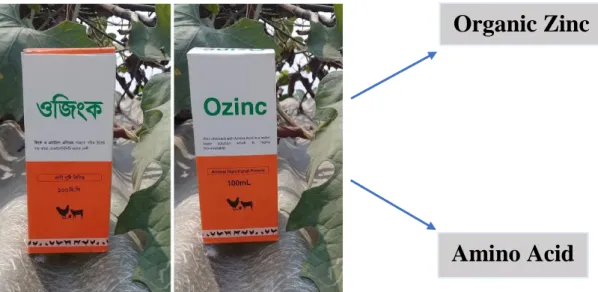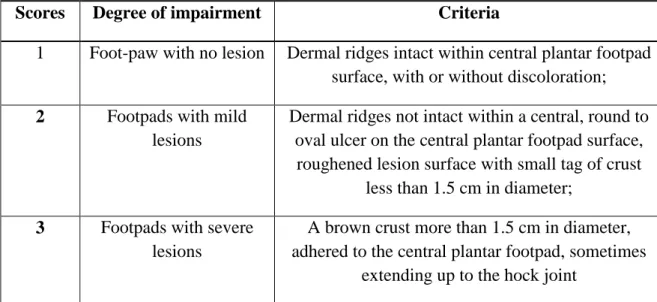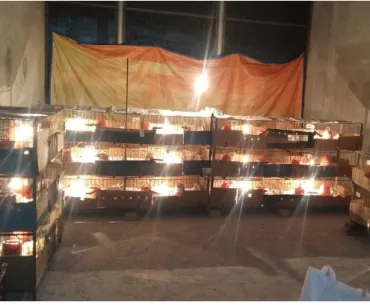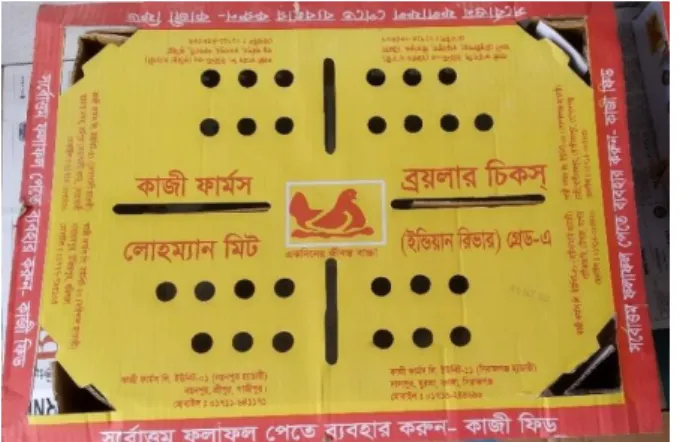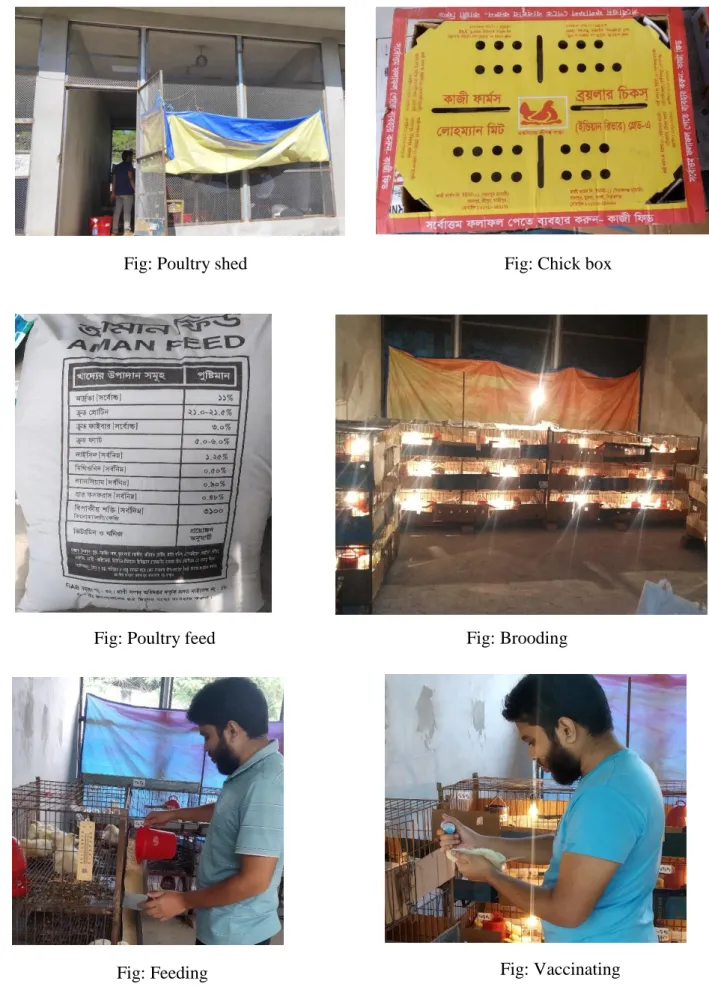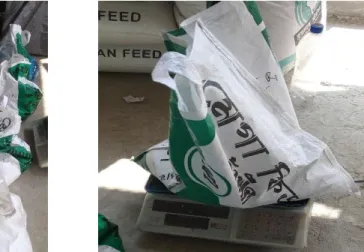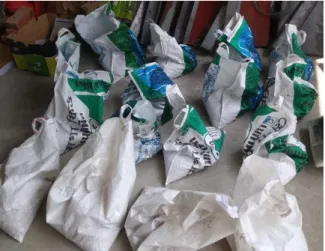46 5.4 Effect of organic zinc on the survivability of broilers 46-47 5.5 Effect of organic zinc on carcass yield and meat. 47 5.7 Water intake of broilers fed organic zinc extract 48 5.9 Effect of organic zinc treated extract on the bone. 8 3-point scoring system of foot pad dermatitis of broilers 29 9 Live weight gain (LWG) (g/w) of organically fed broilers.
37 10 Feed intake (FI) (g/b) of broilers fed with organic zinc extract 38 11 The FCR of broilers fed with organic zinc extract 39 12 Carcass yield characteristics (g) of broilers fed with organic zinc extract 40 13 Weight of the gastrointestinal organs g) fed broilers. 40 14 Incidence of footpad dermatitis (FPD) and gait score. GS) from broiler chickens fed with organic zinc-treated extract.
CHAPTER-I
INTRODUCTION
Chapter-I Introduction
When a corn-soybean meal diet is used, the Zn in the basal diet (usually more than 40 mg/kg) often meets the requirement for chick growth, and there is no significant change in weight gain by Zn supplementation (Wedekind et al. , 1992). On the other hand, weight gain can be influenced by many factors and is not a sensitive measure for Zn requirement estimation (Luo et al., 1991). Tissue Zn accumulation and Zn-containing enzyme activities were considered sensitive criteria, and some required values of Zn were determined based on Zn accumulation in bone (Wedekind et al., 1992).
Through an interaction with a metal-responsive transcription factor (MTF-1), Zn has been shown to regulate a number of genes including MT and ZnT-2 (Lichtlen et al., 2001). In another study, O'Dell et al. 1958) showed that zinc deficiency was responsible for poor growth and abnormal bone development in chicks fed purified diets.
CHAPTER-II _____________
REVIEW OF LITERATURE
Chapter-II Review of literature
- Introduction
- Organic zinc
- Feed intake and feed efficiency
- Growth rate
- Zinc and meat quality of broilers .1 Carcass characteristics
- Carcass quality
- Antioxidant activity of zinc
- Tissue zinc concentration
- Effect of Zinc deficiency on the immune function or viability of broilers
- Effect of organic Zinc on the water consumption of broiler chickens
- Impact of organic Zinc on the leg bone health or bone quality of broiler chickens
- Conclusion
Zinc-deficient mice changed their dietary preferences by avoiding carbohydrates and seeking protein and fat (Kennedy et al., 1998). However, the antioxidant role of zinc can provide an important defense system for the skin (Elizabeth et al., 2002) and limit the production of free radicals, such as the superoxide content in poultry meat. Similarly, Bartlett and Smith (2003) and Hudson et al. 2004a) reported that the immune response of broilers can be influenced by the level of ZnAA in the diet and environmental conditions.
Improper bone development is one of the basic symptoms of Zn deficiency in the diet of birds (El-Husseiny et al., 2012). According to Wang et al. 2002), Zn deficiency (10 mg kg−1) in young birds has a negative effect on skeletal formation.
CHAPTER-III
MATERIALS AND METHODS
Chapter—III Materials and Methods
Statement of the experiment
Preparation of the experimental shed
A total of 112 (Lohman Broiler) day-old broilers of both sexes were purchased from a local well-known hatchery (Kazi Farms Ltd.) on a pre-order basis to conduct the experimental trial from day 1 to day 28. Chickens were weighed immediately after hatching and randomly assigned to four treatments including T1, T2, T3 and T4, and each treatment had four replicates with seven broilers per replicate cage in a completely randomized design (CRD). .
Collection of the experimental feed and feedstuffs
Organic Zinc
Amino Acid
- Management
- Brooding
- Floor space
- Feeding and watering
- Lighting
- Immunization of birds
- Medication
- Sanitation
- Data and sample collection
- Feed sample processing and analyses
- Method for the broiler processing
- Recordkeeping
- Mortality
- Body weight
- Feed intake
- Water intake
- Calculation of data .1 Weight gain
- Feed conversion ratio (FCR)
- Dressing percentage
- Latency to sit test, Gait scoring and Foot pad dermatitis test
- Evaluation of meat yield parameters
- Production cost
- Statistical analyses
After that, the temperature of the poultry house was maintained at 25 °C for the rest of the experiment. Before starting the test, proper cleaning and disinfection of all equipment was done. Both the starter feed sample and the grower feed sample were collected prior to feeding the birds for evaluation of the nutritional value of each diet.
The individual weight of the gastrointestinal organs (liver, heart, proventriculus, gizzards) was also recorded to ascertain the development of the gastrointestinal organs of the birds. After slaughter, the birds were processed by removing the feathers, skin, head, throat, viscera, oil gland, heart, kidney, liver, lung, and small and large intestine of the carcasses. The gizzard and proventriculus were separated from the gastro-intestinal tract by cutting it in front of the duodenum and behind the distal end of the esophagus.
Average live weight of broilers was also recorded at the beginning of the trial and at the end of each weekend. After measuring the bone properties, the samples were ground and put on a muffle furnace at a temperature of 600°C for 4 hours to make ash. HB is closely related to FPD, where the skin on the hock turns dark brown.
FPD is a type of contact dermatitis that affects the plantar region of the feet of poultry and other birds. Both femur bones were collected and boiled for 10 min in deionized water to facilitate removal of attached soft tissue and fat. After obtaining measurements of bone characteristics, the samples were sent to the Department of Animal Science and Nutrition to analyze the concentration of bone minerals.

PICTORIAL PRESENTATION OF ACTIVITIES
DURING EXPERIMENT
CHAPTER-IV _____________
RESULTS
Chapter-IV
Results
- Gross responses of broiler chickens fed organic zinc treated extract (Ozinc)
- Live weight of broiler chicken fed organic zinc extract
- Feed intake of broiler chicken fed organic zinc extract (Ozinc)
- Survivability of broiler chicken fed with organic zinc treated extract
- Gastro-intestinal development of broiler
- Latency to sit test (LTS) of broilers on day25 fed organic zinc treated extract The LTS score was shown graphically. The results of LTS test denote that there had no
- Bone quality and bone mineralization of broiler chicken
It is clear from the BWG data that there was insignificant (P>0.05) difference between treatments on day 28. The data showed that the FI of broilers was not affected by the dietary treatment (P>0.05). 39 | P a g e 4.5 The feed conversion ratio (FRC) of broilers fed organic zinc (Osink). The result shows that VVV was not significantly (P>0.05) affected under the treatment except for 21 days (Table 8).
The survival response of broilers fed organozinc-treated water on d28 was not affected by treatment (P>0.05) (Figure 2). The data show that the carcass yield was numerically (P>0.05) higher in the T3 group than in the others. The result showed that the weights of the ventricle, stomach, liver and heart of the birds were the same between the treatments (P>0.05).
The results of the LTS test showed that there was no significant (P>0.05) effect on the LTS score of broilers on day 25, as shown in Figure 4. The data showed that FPD and GS test of broilers had no effect (P >0 .05) with dietary treatment (Table 11). Numerically (P>0.05) lower FPD and GS scores were observed in the T2 and T3 treatment groups.
The result showed that the bone weight (BW), bone length (BL), bone diameter, bone head width (BHW), calcium (Ca) and phosphorus (P) content of the birds were not affected (P>0.05) by the treatments. Significantly (P<0.05) the highest profit (12.08 Tk/kg) was found for the broiler of T3 treatment group compared to other treatments in this study. Data refer to mean values at the end of the trial period (28 days); Values bearing different superscripts in a row are significantly different between treatment at *P<0.05; Detailed cost of production shown in the Appendix Table].
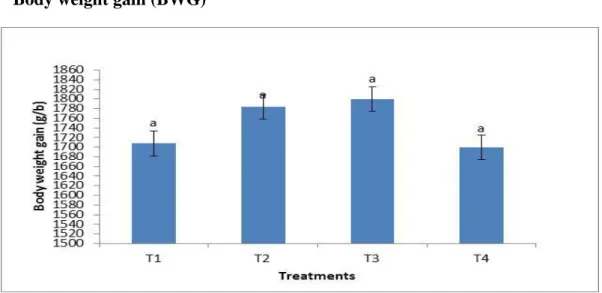
CHAPTER-V _____________
DISCUSSION
Chapter-V Discussion
- Growth performances of broiler chicken fed organic zinc supplemented extract
- Effect of organic zinc supplemented extract on the feed consumption of broiler chicken
- Effect of organic zinc supplemented extract on the feed conversion ratio of broiler chicken
- Effect of organic zinc on the survivability of broiler chicken
- Effect of organic zinc on carcass yield traits of broiler chicken
- Effect of organic zinc on the relative weight of gastro-intestinal organs of broiler chicken
- Effect of organic zinc treated extract on the leg health or bone quality of broiler chicken
Broiler survival data showed that addition of organic zinc extract to water had no significant effect on bird viability or death between treatments. This means that organic zinc treated with water had no adverse effect on the birds, although there was a numerically lower viability (%) of broilers in the control or untreated group. The immune-enhancing properties of organozinc could improve broiler survival (Flinchum et al., 1989; Virden et al., 2004; Guo et al., 2002).
47 | P a g e Furthermore, it can be assumed that organic zinc in the broiler's feed can undoubtedly be used, as it had no harmful effect on the broiler's growth and survivability. It can be assumed that organic zinc can act as a defense mechanism for the body, as it has been reported that it could have a positive effect on broilers (James et al., 1987). Our result agrees with the report of previous researcher who found similar results when broilers fed with organic zinc-supplemented diet (Collins and Moran 1999; Rossi et al., 2007).
In addition, bone bone characteristics and bone minerals, especially Ca and P, were also measured to find out the overall bone quality of broilers fed organic zinc extracts. The results of LTS, FPD and GS tests showed that it had no significant effect on the different treatment groups of broilers fed with organic zinc treated extract. The higher leg length, weight and head width may be a result of better growth performance of broilers fed organic zinc extract, as observed in this study as previous research has shown (Sandoval et al.1998).
Cost-benefit analysis showed that broilers fed a supplemental organic zinc extract in this study gained heavier body weights at the expense of low-cost inclusion. Increased body weight gain and lower cost of production calculated in organic zinc treated group (T2 and T3) may be responsible for higher profit margin. However, poultry fed diets without organic zinc diets and 1.5% organic zinc diets (T4) were seen with lower profit (Tk/Kg live broiler).
CHAPTER-VI
CONCLUSION AND RECOMMENDATIONS
Conclusion and Recommendations
CHAPTER-VII ______________
1980) Effect of zinc deficiency on bone collagenase and collagen turnover 1. 2003) Effects of different zinc levels on performance and immunocompetence of broilers under heat stress. Rationale for the mechanism of zinc interaction in the immune system. eds.), Nutrient modulation of immune response, pg. 2000) Dietary zinc and vitamin E complexes for reducing the incidence of cellulitis in birds. Zinc supplementation with organic and inorganic forms of circulating zinc and protein in zinc-deficient calves. 1964) Mineral utilization in the rat.
2004a) Live performance and immune responses of direct-fed broilers:. influences of the zinc source in the diet of broiler breeders and offspring and the ambient temperature during the production period of broilers. 2004b) Reproductive performance and immune status of caged broiler breeders fed diets supplemented with inorganic or organic zinc sources from hatching to 65 weeks of age. 1997). 1987) Macrophage-mediated depression of T-cell proliferation in zinc-deficient mice. 1989) Effect of zinc deficiency and food restriction. in rats on the zinc, phospholipid and protein content of the erythrocyte membrane. 1998).
Zinc metabolism with special attention to its role in immunity. 2000) Zinc source of turkeys influences offspring immunity and disease resistance. 1961) Effects of zinc deficiency in the diet of chickens. The effects of zinc deficiency on pancreatic carboxypeptidase activity and protein digestion and absorption in the rat. The metabolic role of zinc, with special attention to carbohydrate and lipid metabolism. 1869) Chemical studies on vegetation, Ann. 1980) Ammonia in the atmosphere during brooding affects the performance of broilers. 1989) Influence of egg production on zinc, copper and iron metabolism in the turkey hen (Meleagris gallopavo).
Movement of zinc and copper from the fertilized egg to metallothionein-like proteins in developing chicken liver tissue. 1998) US Food Sources of Nutrients 2008) Effects of Higher Levels of Zinc Supplementation on Performance, Mineral Availability, and Immune Performance in Broiler Chickens. 2005) Effect of zinc sulfate and zinc methionine on growth, plasma growth hormone concentration, growth hormone receptor, and insulin-like growth factor-1 gene expression in mice.
CHAPTER-VIII _______________
APPENDIX
Brief Bio-data of the Author

